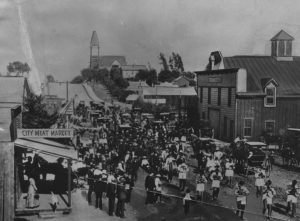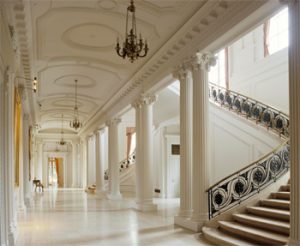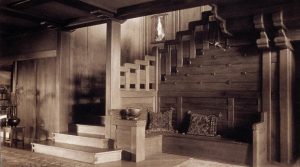While on a mission to the Huntington Library, San Marino, California, as William Reece Fellow, I have noticed that the architectural inheritance in the towns of Pasadena/San Marino complements the story of the collectors of rare books and the history of the collections I am researching in the library.
For many successful American businessmen moving to California at the time was a means of finding a comfortable warm country residence in the winter. Pasadena was advertised as a cool mountain resort, similar to the Côte d’Azur – its winter flower festival was set up at the turn of the century to rival that of Nice.  The citrus fruits that grew there were a further Mediterranean reminder : one of Pasadena’s main thoroughfares is named Orange Grove Boulevard. The attraction of the town was such that during the first decade of the 20th century it witnessed a population boom, tripling from under ten thousand to over thirty thousand in those ten years.
The citrus fruits that grew there were a further Mediterranean reminder : one of Pasadena’s main thoroughfares is named Orange Grove Boulevard. The attraction of the town was such that during the first decade of the 20th century it witnessed a population boom, tripling from under ten thousand to over thirty thousand in those ten years.
At the beginning of the XXth century, within a dozen or so years, and within a radius of a few kilometers, two collectors of rare books and a businessman had residences built which were significant not just for their size, but also for their architectural features and their contents.
Henry Edwards Huntington moved into his newly commissioned Beaux Arts style house, designed by Myron Hunt, in 1911.  He had been sent on business to California in the 1890s – involved in Pacific railroad, he then took on plan to buy up & unify electric train network in and around Los Angeles. He retired in 1910, after which he devoted his whole time to building his collections of books and plants, and, after his marriage in 1913, his wife’s art & furniture collections, and setting up his library, all, at first, housed in his residence. The ranch he bought was to be the site of this cultural and horticultural endeavour.
He had been sent on business to California in the 1890s – involved in Pacific railroad, he then took on plan to buy up & unify electric train network in and around Los Angeles. He retired in 1910, after which he devoted his whole time to building his collections of books and plants, and, after his marriage in 1913, his wife’s art & furniture collections, and setting up his library, all, at first, housed in his residence. The ranch he bought was to be the site of this cultural and horticultural endeavour.
 Gamble House, built for the heir to the conglomerate Proctor & Gamble Co. of Ciccinati (Ohio) by architects Greene & Greene in 1904, is a marvellous example of the Arts & Crafts style with Tiffany glassware and windows, and hand-crafted wooden interiors and furniture of stream-lined modernity, built on the cool pine-scented slopes of the Arroyo Secco valley. Its exterior will be recognized by film buffs at the home of Doc. (Emmett Brown) in the Back to the Future films.
Gamble House, built for the heir to the conglomerate Proctor & Gamble Co. of Ciccinati (Ohio) by architects Greene & Greene in 1904, is a marvellous example of the Arts & Crafts style with Tiffany glassware and windows, and hand-crafted wooden interiors and furniture of stream-lined modernity, built on the cool pine-scented slopes of the Arroyo Secco valley. Its exterior will be recognized by film buffs at the home of Doc. (Emmett Brown) in the Back to the Future films.
A further example of residential novelty is Henry Raup Wagner’s home, 1124 Winston Avenue, San Marino, CA. built in 1928, in one of the many wide suburban streets where comfortable villas were developing,  probably so that he could be in the neighbourhood of the new Huntington Library, half a mile away where his books and tens of thousands of others were housed. Having sold one of his collections to Huntington, he was often railed that he could not let it go. The house’s neo-gothic windows, in keeping with Wagner’s love of rare antiquarian books and his wife’s love of Byzantine art, are a remarkable feature even today. « Mr. Wagner’s swivel chair and desk stood between two of the Gothic windows on the facade of the house » recorded his amanuensis, Ruth Axe Frey (1981, p.35).
probably so that he could be in the neighbourhood of the new Huntington Library, half a mile away where his books and tens of thousands of others were housed. Having sold one of his collections to Huntington, he was often railed that he could not let it go. The house’s neo-gothic windows, in keeping with Wagner’s love of rare antiquarian books and his wife’s love of Byzantine art, are a remarkable feature even today. « Mr. Wagner’s swivel chair and desk stood between two of the Gothic windows on the facade of the house » recorded his amanuensis, Ruth Axe Frey (1981, p.35).
Wagner had previously lived in Berkeley, at 90 Camino El Real, two miles from another significant research library set up by bibliophile bookseller and publisher, Hubert Howe Bancroft, The Bancroft Library opened in 1905, following the sale to the University of California, of his book collection specializing in the American West.
Wagner retired from his activities with Meyer Guggenheim’s American Smelting & Refining Company in 1917, the year he married late in life Blanche Collet Wagner, his French-born wife, whom he had met in Mexico. He was to devote the following forty years to bibliography and history, collecting further numerous new collections of rare antiquarian books, and writing monographs and studies on their subject matter. His first collections on the subjects of mining, then economic history, were made before he retired, using the same book sellers as Auguste Dubois, who was buying rare economic pamphlets and books at the same time, namely, for example Leon Kashnor of the Museum Bookstore, London.
These men lived in a golden intellectual circle, and were willing to devote their wealth to cultural pursuits, vast in the case of Huntington & Gamble, comfortable in Wagner’s, settle in California and have residences built, one in the pure Gilded Age style, or the neo-Mediterranean California style, the other two of a more pared-back style rejecting opulence and pomp for natural simplicity.

